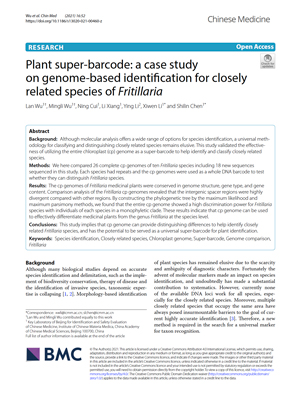NEWS 2021
Plant Super-barcode: A Case Study on Genome-based Identification for Closely Related Species of Fritillaria
Lan WU1, Mingli WU1, Ning CIU1, Li XIANG1, Ying LI2, Xiwen LI1, Shilin CHEN1
Chinese medicine (2021)
https://doi.org/10.1186/s13020-021-00460-z
1, Key Laboratory of Beijing for Identification and Safety Evaluation of Chinese Medicine, Institute of Chinese Materia Medica, China Academy of Chinese Medical Sciences, Beijing 100700, China
2, Institute of Medicinal Plant Development, Chinese Academy of Medical Sciences & Peking Union Medical College, Beijing 100193, China
Abstract
Background: Although molecular analysis offers a wide range of options for species identification, a universal methodology for classifying and distinguishing closely related species remains elusive. This study validated the effectiveness of utilizing the entire chloroplast (cp) genome as a super-barcode to help identify and classify closely related species.
Methods: We here compared 26 complete cp genomes of ten Fritillaria species including 18 new sequences sequenced in this study. Each species had repeats and the cp genomes were used as a whole DNA barcode to test whether they can distinguish Fritillaria species.
Results: The cp genomes of Fritillaria medicinal plants were conserved in genome structure, gene type, and gene content. Comparison analysis of the Fritillaria cp genomes revealed that the intergenic spacer regions were highly divergent compared with other regions. By constructing the phylogenetic tree by the maximum likelihood and maximum parsimony methods, we found that the entire cp genome showed a high discrimination power for Fritillaria species with individuals of each species in a monophyletic clade. These results indicate that cp genome can be used to effectively differentiate medicinal plants from the genus Fritillaria at the species level.
Conclusions: This study implies that cp genome can provide distinguishing differences to help identify closely related Fritillaria species and has the potential to be served as a universal super-barcode for plant identification.




